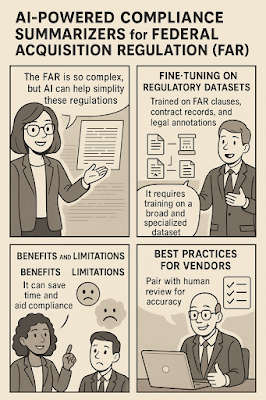AI-Powered Compliance Summarizers for Federal Acquisition Regulation (FAR)
AI-Powered Compliance Summarizers for Federal Acquisition Regulation (FAR)
The Federal Acquisition Regulation (FAR) is a colossal document—thousands of pages of legal guidelines, pricing rules, and procurement mandates.
And if you’ve ever tried decoding FAR clauses while racing against a proposal deadline, you already know: it’s not for the faint of heart.
Enter AI-powered compliance summarizers: tools built to translate that tangled legalese into something mere mortals can understand—and act on.
In this post, we’ll explore how FAR summarization engines work, where they fit in the acquisition life cycle, and what risks or rewards they bring to compliance-conscious vendors.
Table of Contents
- What Are FAR Summarization Engines?
- Use Cases in Procurement Life Cycle
- Fine-Tuning on Regulatory Datasets
- Benefits and Limitations
- Best Practices for Vendors
What Are FAR Summarization Engines?
A FAR summarization engine is a specialized AI tool that ingests legal documents and distills them into digestible summaries.
Unlike general-purpose chatbots, these tools are trained on legal corpora—FAR clauses, GAO rulings, audit logs, contract disputes—anything that helps them learn the language of government procurement.
The goal? Help humans make sense of dense, layered, and often cross-referenced regulations—without sacrificing legal accuracy.
Picture this: your team is drafting a proposal, and you stumble upon a clause you’re unfamiliar with. Instead of calling in legal counsel, you ask your AI tool: “What’s the implication of FAR 15.305(b) in a CPFF contract?”
Within seconds, you get a paragraph summarizing the requirement to evaluate past performance and how it interacts with pricing structure. That’s powerful—and fast.
Use Cases in Procurement Life Cycle
These summarizers aren’t just glorified auto-completes—they have real-world applications at every phase of federal acquisition.
1. Pre-Award Stage: Vendors can use summarizers to dissect complex RFPs, identifying clauses about evaluation criteria, small business subcontracting, or pre-negotiation requirements.
2. During Contract Execution: They flag deliverables, inspection procedures, or risk language, such as cure notices or liquidated damages clauses.
3. Post-Award Audit Readiness: Summarizers assist in ensuring that documentation aligns with FAR recordkeeping standards, especially in high-risk areas like timekeeping or indirect costs.
Some even plug into CLM (Contract Lifecycle Management) platforms, offering real-time clause recommendations and change impact summaries.
Fine-Tuning on Regulatory Datasets
Behind every reliable FAR summarizer lies a surprisingly rich training regimen.
These AI tools are not just reading regulations—they’re studying decades of annotated contract decisions, clause trees, DFARS supplements, and even legislative intent summaries.
Vendors often start with open-source data like the FAR XML archive from NIST or the Code of Federal Regulations, layering in proprietary interpretations from legal experts and compliance officers.
Some startups even employ procurement lawyers to annotate tricky clauses—like those involving cost realism or Buy American Act thresholds—to refine the summarizer’s accuracy.
Reinforcement learning is increasingly common: if a user flags a summary as misleading, the model gets nudged to do better next time.
It’s not just about language—it’s about context. These tools learn that a clause might mean different things under DHS versus NASA contracts, even if the reference is the same.
Like wine and procurement rules, the nuance comes with age—and good metadata.
Benefits and Limitations
Let’s be honest: no one wakes up excited to read FAR 52.215-22 before breakfast.
That’s why summarizers are gaining popularity—because they save real time and cognitive load.
Key Benefits Include:
Faster proposal development with automated clause insights
Streamlined redlining and contract negotiation workflows
Reduced legal dependency for standard compliance checks
But Let’s Not Ignore the Drawbacks:
Context blindness: Summarizers may misinterpret clauses without broader regulatory references.
Update lag: FAR changes monthly, and some tools fail to refresh timely.
Overconfidence: Users may rely too heavily on AI without validating against primary text.
Some vendors mitigate these risks by embedding disclaimers or confidence scores—like “summary 85% likely accurate” tags—next to AI output.
Others enable “source view” features so users can see which part of the regulation influenced the summary, like a highlighter revealing its thought process.
It’s far from perfect, but a human lawyer with AI assistance is usually faster (and cheaper) than going solo.
Best Practices for Vendors
So, you’re intrigued. Maybe you’re piloting one of these summarizers for the next bid cycle—or planning to integrate one into your internal review process.
Here are some best practices from the field:
1. Don’t Trust, Verify: Treat every AI summary as a first draft. Always cross-reference high-risk sections with the actual FAR language.
2. Human Review Is Not Optional: For clauses involving costs, terminations, or IP rights, get legal sign-off—automated or not.
3. Check Update Cadence: Ensure the vendor retrains models monthly or quarterly. If not, you’re building compliance off outdated assumptions.
4. Log Everything: Maintain versioned logs of each summary used in proposals—especially if you're ever questioned post-award.
5. Prioritize Tools With Explainability: If your tool can’t show you how it reached a conclusion, find one that can. Transparency equals trust.
Used wisely, these tools make compliance teams more agile, more scalable, and more prepared to deal with complexity. Just don’t expect miracles. They’re copilots—not captains.
AI compliance tools are no longer optional in the fast-evolving world of federal contracting—they’re becoming essential companions.
But here’s the truth: summarization engines are only as smart as their training, and only as safe as the humans who review their work.
Rather than replacing your legal team, think of these tools as interns who never sleep but still need supervision.
When paired with strong oversight, they can accelerate compliance, reduce bid errors, and keep your team focused on strategy—not legal scavenger hunts.
Whether you're chasing a GSA Schedule award or managing post-award audits, leveraging AI summarization engines that decode FAR complexity may just be your secret weapon.
And who knows? You might even get through a whole solicitation without a migraine.
By blending automated clause summarization, real-time FAR interpretation, and contract-specific context, vendors can win smarter, bid faster, and sleep better.
Relevant keywords: FAR summarization, federal acquisition compliance, contract AI tools, regulatory NLP, government procurement.
